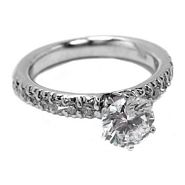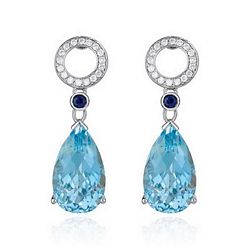Diamond Color
Diamond Color Basics
The Gemological Institute of America, known as the GIA for short, is the most commonly used system for evaluating diamond color. They've created something known as the “GIA Color Grade Scale”, and it has placed a grading system on the many different colors and shades of diamonds, classifying diamonds into 22 letter grades.
Before we show you the diamond color grading scale from the GIA, let’s examine the Diamond Color Grading Procedure. And by the way, for those of you who don’t know, GIA is recognized as the world's foremost authority in gemology.
Diamond Color Grading Procedure
The Gemological Institute of America has certified diamond color grades as “master color comparison” diamonds. When a diamond is being graded, it is compared against these master color comparison grades, to find the shades that match it most closely.
The diamond that is being graded must be thoroughly cleaned and all oil must be removed from the surface before being examined, since even small amounts of dirt or oils on the surface of the diamond can alter the color.
A line of master color comparison diamonds or shade chart is set up, with each grade placed about one inch apart, ranging from the lightest and highest graded D shade, to the darkest, graded Z diamonds. The diamond color that is being graded is moved from the left side of the comparison units to the right, until it matches one of the shades.
Diamond grading should take place in a colorless environment, using a balanced fluorescent light source that has a filtered, cool white sun like ray. The room where the grading takes place is dark, all except for the special grading light, in order to obtain the most accurate grading of the diamond color.
Fluorescence of Diamonds Yet another consideration when considering the diamond color is diamond fluorescence, and how it will affect the actual appearance in the diamond color. Fluorescence causes some diamonds to change color when viewed in our everyday, ultraviolet lighting, as well as under fluorescent light bulbs.
When diamond color is graded, the strength of the fluorescence of that diamond must also be indicated. It may be considered to be strong, moderate, or weak fluorescence, and the reports must also indicate what color the diamond will change to due to the fluorescence.
The reason for this is when people are in the jewelry store, looking at diamonds in the special lighting of the store, they may all appear to be the colorless, transparent diamonds. After buying a diamond and getting it home under normal lighting conditions, you could find your diamond is yellowish in color.
You can ask your jeweler to provide grading documentation and information about the fluorescent value of a particular diamond before purchasing, to make sure that you will be happy with the diamond you buy. Many jewelers also can show you the diamond under different lighting conditions, which will enable you to fully appreciate the beauty of the diamond before you buy it.
Some individuals like a diamond color with a darker shade, while others are insistent on the transparent diamond color. The diamond color is one of personal preference, so be sure to perform your due diligence research before making your final selection.
How Does Diamond Color Affect Cost? Let’s start with a 1 ct. diamond with VS1 clarity and K color. Using the GIA color grading
scale, your color rating will be in the top graph.
Upgrade to an F color and you will see an increase of approximately $1,100 per carat.
Improve the color to D and the increase will be approximately $1,700 per carat. Diamonds are grouped into two color
categories:
1. Colorless or White Diamonds fall within GIA's D to Z color grading scale. When you think of a
colorless stone, just think of crystal clear pure water. These diamonds are traditionally used for engagement rings
and other fine jewelry.
Go back to: The Buying Diamonds Guide. Go back to: The 4 C's of Diamonds Source: Vicente Ross, DiamondExperts.biz
|
Diamonds Are Forever
Buying Diamonds Guide | Diamond Rings | Diamond Earrings | Diamond Engagement Ring
Wedding Rings | Black Diamonds | Blue Diamond Ring | Diamond Bracelet | Tiffany Diamonds
Loose Diamonds | Fake Diamonds | Famous Diamonds | Bonded Diamonds | Colored Diamonds
Wholesale Diamonds | Platinum Wedding Ring | Diamond Solitaire Ring | Yellow Diamonds
Diamond Jewelry Resources
Jewelers Vigilance Committee | Gemological Institute of America | The Jewelers Board of Trade
American Institute Of Diamond Cutting
|
Blood Diamonds |
Stop Blood Diamonds
Join Stop Blood Diamonds |
Diamond Glossary |
Diamond FAQs |
Diamond Mine
The 4 C's of Diamonds | Diamond
Appraisal | Diamond Certificate
Fine Jewelry Resources
How To Find a
Great Jewelry Repair Shop | How To a Avoid Jewelry Repair
Fiasco | The Jewelry Repair
Guide
Man Made Diamonds
Apollo Diamond | CARAT
| Cubic Zirconia | Diamond Nexus |
Gemisis Cultured Diamond
Moissanite Jewelry | Russian
Diamonds | Swarovski Crystals |White
Sapphire
DIAMONDEXPERTS.BIZ is the leading diamond jewelry and fine jewelry resource on the Internet. We
provide up to date information on all types of diamonds and associated jewelry. Our primary mission is to help you
find the best deal possible on genuine diamond jewelry.
Copyright © Diamond Experts 1997-2012 All Rights Reserved.
Privacy Policy
Powered by the Buy Jewelry
Online
Diamond Experts
Diamond Cutters and Polishers, Goldsmiths, Top-Tier Designers and Diamond
Setting Masters
Antwerp Jewels & Diamond
Manufacturers
Antwerp / Belgium / Brazil / Canada / Europe / Italy / USA and
Worldwide



 Facebook
Facebook Twitter
Twitter Delicious
Delicious Livejournal
Livejournal Reddit
Reddit Stumbleupon
Stumbleupon Yahoo My Web
Yahoo My Web Google Bookmarks
Google Bookmarks BlinkList
BlinkList Digg
Digg Blogmarks
Blogmarks Diigo
Diigo Fark
Fark Ma.gnolia
Ma.gnolia Netvouz
Netvouz Newsvine
Newsvine Slashdot
Slashdot Spurl
Spurl Technorati
Technorati Wists
Wists